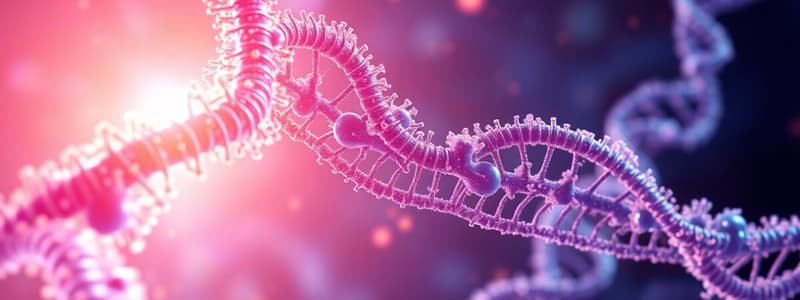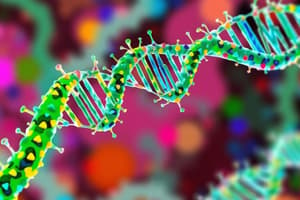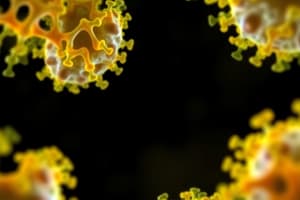Podcast
Questions and Answers
What is the primary function of histone acetyltransferases (HATs)?
What is the primary function of histone acetyltransferases (HATs)?
- To condense chromatin, inhibiting transcription.
- To add acetyl groups to histones, decreasing positive charge. (correct)
- To remove acetyl groups from histones, increasing positive charge.
- To bind to methylated histones, promoting gene silencing.
Which of the following describes euchromatin?
Which of the following describes euchromatin?
- An open and accessible form of chromatin, promoting gene transcription. (correct)
- A region rich in methylated histones, leading to gene silencing.
- A condensed form of chromatin that inhibits gene transcription.
- A tightly packed nucleosome structure, blocking transcription factors.
What is the role of bromodomains in gene regulation?
What is the role of bromodomains in gene regulation?
- They facilitate the removal of acetyl groups from histones, repressing transcription.
- They directly recruit RNA polymerase II to the promoter of a gene.
- They bind to methylated DNA, leading to gene silencing.
- They bind to acetylated histones, attracting chromatin remodeling complexes. (correct)
How can transcription repressors on silencer elements inhibit gene transcription?
How can transcription repressors on silencer elements inhibit gene transcription?
What is a direct consequence of nucleosomes preventing transcription?
What is a direct consequence of nucleosomes preventing transcription?
What is the main type of electrostatic interaction between DNA and histones?
What is the main type of electrostatic interaction between DNA and histones?
In the context of chromatin remodeling, what do ATP-dependent enzymes primarily facilitate?
In the context of chromatin remodeling, what do ATP-dependent enzymes primarily facilitate?
What is the primary reason for regulating gene expression?
What is the primary reason for regulating gene expression?
Which histone modification is typically associated with gene silencing?
Which histone modification is typically associated with gene silencing?
During which phase can the regulation of gene expression occur?
During which phase can the regulation of gene expression occur?
What is the role of the N-terminal tail in histone proteins?
What is the role of the N-terminal tail in histone proteins?
Which of the following is NOT a typical function of corepressors?
Which of the following is NOT a typical function of corepressors?
Which example is considered a short-term regulation of gene expression?
Which example is considered a short-term regulation of gene expression?
What is the role of transcription factors in gene expression?
What is the role of transcription factors in gene expression?
What is the effect of histone acetylation in the context of gene expression?
What is the effect of histone acetylation in the context of gene expression?
What is the purpose of tissue-specific gene regulation?
What is the purpose of tissue-specific gene regulation?
How does the information in DNA become a protein?
How does the information in DNA become a protein?
What happens after a protein is made?
What happens after a protein is made?
What is the primary function of basic transcription factors?
What is the primary function of basic transcription factors?
Specific transcription factors are best described by which of the following traits?
Specific transcription factors are best described by which of the following traits?
Where is the core promoter located relative to the gene it regulates?
Where is the core promoter located relative to the gene it regulates?
Which of the following best describes enhancer and silencer elements?
Which of the following best describes enhancer and silencer elements?
What is the main function of cohesins and condensins in gene regulation?
What is the main function of cohesins and condensins in gene regulation?
Which of these is NOT a characteristic of a core promoter?
Which of these is NOT a characteristic of a core promoter?
How do enhancers and silencers influence gene transcription?
How do enhancers and silencers influence gene transcription?
What is the role of co-activators?
What is the role of co-activators?
Given the provided information, which statement about the location of enhancer/silencer elements is most accurate?
Given the provided information, which statement about the location of enhancer/silencer elements is most accurate?
What is the transcription start site?
What is the transcription start site?
What is the primary role of transcription factors in the process of transcription?
What is the primary role of transcription factors in the process of transcription?
Which event signals the release of RNA Polymerase II from the promoter and the start of transcription elongation?
Which event signals the release of RNA Polymerase II from the promoter and the start of transcription elongation?
Which of the following best describes the function of co-activators in gene transcription?
Which of the following best describes the function of co-activators in gene transcription?
What is the function of the DNA-binding domain found in all transcription factors?
What is the function of the DNA-binding domain found in all transcription factors?
What determines the specificity of a transcription factor for a particular DNA sequence?
What determines the specificity of a transcription factor for a particular DNA sequence?
How do transcription factors that act as repressors inhibit gene transcription?
How do transcription factors that act as repressors inhibit gene transcription?
A transcription factor binds to a DNA sequence with the motif 'TATAAAA'. Which similar sequence is it also likely to bind to?
A transcription factor binds to a DNA sequence with the motif 'TATAAAA'. Which similar sequence is it also likely to bind to?
What is the termination signal for transcription in the newly formed mRNA?
What is the termination signal for transcription in the newly formed mRNA?
What is the role of the trans-activation/trans-repression domain found in transcription factors?
What is the role of the trans-activation/trans-repression domain found in transcription factors?
What is the effect of ligand binding to a transcription factor, when a ligand-binding domain is present?
What is the effect of ligand binding to a transcription factor, when a ligand-binding domain is present?
What is the primary effect of histone acetylation on chromatin structure?
What is the primary effect of histone acetylation on chromatin structure?
Which protein domain is typically found in transcription factors and chromatin remodeling proteins that recognizes acetylated histones?
Which protein domain is typically found in transcription factors and chromatin remodeling proteins that recognizes acetylated histones?
How do histone deacetylases (HDACs) contribute to gene regulation?
How do histone deacetylases (HDACs) contribute to gene regulation?
What is the primary role of histone acetyltransferases (HATs) during gene regulation?
What is the primary role of histone acetyltransferases (HATs) during gene regulation?
What is a consequence of recruiting histone deacetylases to a gene promoter region?
What is a consequence of recruiting histone deacetylases to a gene promoter region?
Which of the following is a mechanism used by transcription factors to activate gene expression?
Which of the following is a mechanism used by transcription factors to activate gene expression?
How does the position of acetyl groups on histones influence gene expression?
How does the position of acetyl groups on histones influence gene expression?
How is tissue-specific gene regulation achieved given that all cells contain the same DNA?
How is tissue-specific gene regulation achieved given that all cells contain the same DNA?
What is the primary role of tissue- and cell type-specific transcription factors?
What is the primary role of tissue- and cell type-specific transcription factors?
Which of the following best describes the activity of enhancers?
Which of the following best describes the activity of enhancers?
What is the role of histone modifications, such as acetylation, in the context of enhancer activity?
What is the role of histone modifications, such as acetylation, in the context of enhancer activity?
In the context of lung fibroblasts and hepatocytes, what is the key difference in histone modification and enhancer activity?
In the context of lung fibroblasts and hepatocytes, what is the key difference in histone modification and enhancer activity?
What role does the silencer play in the expression of gene X in the example?
What role does the silencer play in the expression of gene X in the example?
Considering the presented information on tissue-specific gene regulation, how would the activity of an enhancer differ between the two tissues?
Considering the presented information on tissue-specific gene regulation, how would the activity of an enhancer differ between the two tissues?
What is a possible consequence of having different sets of transcription factors in different types of lung epithelial cells?
What is a possible consequence of having different sets of transcription factors in different types of lung epithelial cells?
In the cases of the fibroblasts and the hepatocytes, how does condensed/open chromatin influence the enhancer activity?
In the cases of the fibroblasts and the hepatocytes, how does condensed/open chromatin influence the enhancer activity?
Flashcards
Gene Transcription
Gene Transcription
The process by which genetic information encoded in DNA is transcribed into RNA, which is then translated into proteins.
Gene Regulation
Gene Regulation
The process by which cells control which genes are expressed and at what levels.
Epigenetic Regulation
Epigenetic Regulation
Changes in gene expression that are not due to alterations in the DNA sequence but are instead influenced by environmental factors or cellular signals. These changes can be inherited or reversible.
Transcription Factors
Transcription Factors
Signup and view all the flashcards
Regulatory DNA Sequences
Regulatory DNA Sequences
Signup and view all the flashcards
Chromatin Remodeling
Chromatin Remodeling
Signup and view all the flashcards
Histone Acetylation
Histone Acetylation
Signup and view all the flashcards
Tissue-Specific Gene Expression
Tissue-Specific Gene Expression
Signup and view all the flashcards
Core promoter
Core promoter
Signup and view all the flashcards
Transcription factors (TFs)
Transcription factors (TFs)
Signup and view all the flashcards
Pre-initiation complex
Pre-initiation complex
Signup and view all the flashcards
Transcription bubble
Transcription bubble
Signup and view all the flashcards
Co-activators/co-repressors
Co-activators/co-repressors
Signup and view all the flashcards
DNA-binding domain
DNA-binding domain
Signup and view all the flashcards
Trans-activation/trans-repression domain
Trans-activation/trans-repression domain
Signup and view all the flashcards
Transcription factor binding motifs
Transcription factor binding motifs
Signup and view all the flashcards
Basic and specific transcription factors
Basic and specific transcription factors
Signup and view all the flashcards
Ligand-binding domain
Ligand-binding domain
Signup and view all the flashcards
Basic Transcription Factors
Basic Transcription Factors
Signup and view all the flashcards
Specific Transcription Factors
Specific Transcription Factors
Signup and view all the flashcards
Enhancers and Silencers
Enhancers and Silencers
Signup and view all the flashcards
Basal Transcription Factors
Basal Transcription Factors
Signup and view all the flashcards
Transcriptional Activators
Transcriptional Activators
Signup and view all the flashcards
Transcriptional Repressors
Transcriptional Repressors
Signup and view all the flashcards
Enhancer/Silencer Regulation
Enhancer/Silencer Regulation
Signup and view all the flashcards
Co-activators and Co-repressors
Co-activators and Co-repressors
Signup and view all the flashcards
Cohesins and Condensins
Cohesins and Condensins
Signup and view all the flashcards
Tissue-Specific Transcription Factors
Tissue-Specific Transcription Factors
Signup and view all the flashcards
Tissue-Specific Enhancer/Silencer Activity
Tissue-Specific Enhancer/Silencer Activity
Signup and view all the flashcards
Condensed Chromatin
Condensed Chromatin
Signup and view all the flashcards
Open Chromatin
Open Chromatin
Signup and view all the flashcards
Cell Differentiation
Cell Differentiation
Signup and view all the flashcards
What is histone acetylation?
What is histone acetylation?
Signup and view all the flashcards
What is the role of bromodomains in gene regulation?
What is the role of bromodomains in gene regulation?
Signup and view all the flashcards
What is the role of histone deacetylases in gene regulation?
What is the role of histone deacetylases in gene regulation?
Signup and view all the flashcards
How do transcription activators affect histone acetylation?
How do transcription activators affect histone acetylation?
Signup and view all the flashcards
How do transcription repressors affect histone acetylation?
How do transcription repressors affect histone acetylation?
Signup and view all the flashcards
Why do different cells have different gene expression patterns?
Why do different cells have different gene expression patterns?
Signup and view all the flashcards
What are chromatin remodelling complexes and what do they do?
What are chromatin remodelling complexes and what do they do?
Signup and view all the flashcards
How is tissue-specific gene expression controlled?
How is tissue-specific gene expression controlled?
Signup and view all the flashcards
Chromatin opening
Chromatin opening
Signup and view all the flashcards
Euchromatin
Euchromatin
Signup and view all the flashcards
Heterochromatin
Heterochromatin
Signup and view all the flashcards
RNA polymerase II (RNA Pol II)
RNA polymerase II (RNA Pol II)
Signup and view all the flashcards
Silencer elements
Silencer elements
Signup and view all the flashcards
Co-repressors
Co-repressors
Signup and view all the flashcards
Nucleosome
Nucleosome
Signup and view all the flashcards
ATP-dependent chromatin remodeling enzymes
ATP-dependent chromatin remodeling enzymes
Signup and view all the flashcards
Histone modifications
Histone modifications
Signup and view all the flashcards
Study Notes
Gene Expression & Regulation
- Gene expression is controlled in time and space. Every cell has the same DNA, but different genes need to be "on" and "off" in different cell types. This regulation is essential for cell diversity.
Lecture Objectives
- Understanding the fundamental structures and types of transcription factors and their roles in transcriptional regulation.
- Understanding the pivotal role of regulatory DNA sequences in regulating gene transcription.
- Grasping the significance of histone acetylation and chromatin remodeling in the regulation of gene transcription.
- Familiarizing with the core concepts of tissue-specific regulation of gene transcription.
Gene Regulation
- Gene expression is regulated at various levels, including short-term (e.g., responding to external signals like growth factors or hormones) and long-term (e.g., tissue-specific identity maintained through cell division).
- Epigenetic modifications (e.g., chromatin remodeling), transcriptional, post-transcriptional, and translational mechanisms all play a role in regulating gene expression.
Gene Expression During Development
- Gene expression is dynamic across the life cycle. Different genes need to be "on" or "off" at various stages.
Gene Regulation During Transcription
- DNA is transcribed into mRNA.
- mRNA is translated into proteins.
- Protein activity leads to a phenotype.
Transcription Initiation
- RNA Pol II binds to a non-coding DNA region (core promoter).
- Transcription factors (TFs) guide RNA Pol II to the core promoter.
- RNA Pol II and TFs form a pre-initiation complex.
- RNA Pol II phosphorylation initiates transcription.
Transcription Elongation
- RNA Pol II unwinds the DNA ("transcription bubble").
- RNA Pol II uses one strand as a template to synthesize a complementary RNA sequence.
- RNA Pol II adds nucleotides to the 3' end of the growing RNA molecule.
Transcription Termination
- RNA Pol II encounters a termination signal (e.g., AAUAAA hexamer).
- Transcription stops.
- RNA Pol II and mRNA are released.
- A new transcription cycle begins.
Transcription Factors
- Transcription factors are proteins that bind specific DNA sequences and control gene transcription (activating or inhibiting).
- Most transcription factors work with other proteins (co-activators/co-repressors) to regulate transcription.
- Transcription factors can either activate or repress transcription. Activators recruit co-activators, and repressors recruit co-repressors.
Transcription Factor Domains
- Transcription factors have specific structural domains for interaction with DNA or other proteins.
- DNA-binding domains recognize specific short DNA sequences (transcription factor binding motifs).
- Trans-activation/trans-repression domains interact with co-activators or co-repressors.
- Some factors have ligand-binding domains (e.g., hormone receptors)
- Some have dimerization domains (to bind to DNA in pairs).
Regulatory DNA Sequences
- Core promoter: Immediately upstream of the gene
- Contains the transcription start site (+1)
- Binding sites for basal transcription factors
- Needed for gene transcription
- Enhancers/Silencers: Can be upstream or downstream of a gene, and affect the activity of the core promoter (increasing or decreasing).
- Enhancers/silencers can be far from the target gene, but transcription factors bring them close through chromatin looping.
Co-activators and Co-repressors
- Co-activators increase gene transcription by opening chromatin.
- Co-activators recruit RNA Pol II and basal transcription factors to the promoter.
- Co-repressors decrease gene transcription by inducing chromatin condensation.
- Co-repressors prevent RNA Pol II recruitment to the promoter.
Histone Modifications and Chromatin Remodeling
- Nucleosomes (DNA wrapped around histone proteins) can block access for transcription factors.
- Chromatin remodeling enzymes (e.g. ATP-dependent chromatin remodeling enzymes) reposition or remove nucleosomes.
- Histone modifications (e.g., acetylation) affect chromatin structure.
Histone Acetylation
- Histone acetyltransferases (HATs) add acetyl groups to lysines on histones.
- Histone deacetylases (HDACs) remove acetyl groups.
- Bromodomains are special protein modules found in transcription factors, as well as chromatin remodeling complexes, which recognise acetylated lysine residues on histones.
Tissue-Specific Regulation
- Every cell has the same genes, but different genes are expressed in different tissues and cells.
- Tissue-specific transcription factors regulate gene transcription.
- Enhancers/silencers have tissue-specific activity, determined by histone modifications.
Studying That Suits You
Use AI to generate personalized quizzes and flashcards to suit your learning preferences.




